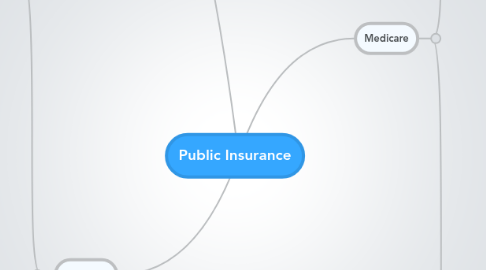
1. Medicaid
1.1. Positive
1.1.1. Services Included
1.1.1.1. Always
1.1.1.1.1. Prenatal care
1.1.1.1.2. Diagnostic services
1.1.1.1.3. Family prevention services and supplies
1.1.1.1.4. Hospital inpatient and outpatient care
1.1.1.1.5. Physician services
1.1.1.1.6. Other
1.1.1.2. Optional
1.1.1.2.1. Prescription drugs
1.1.1.2.2. Prostheses
1.1.1.2.3. Eyeglasses
1.1.1.2.4. Transportation
1.1.1.2.5. Rehabilitation
1.1.1.2.6. Home- and community-based services
1.1.1.2.7. Other
1.2. Negative
1.2.1. Only eligible to
1.2.1.1. A member of a family with children receiving support under the Temporary Assistance for Needy Families (TANF) program
1.2.1.2. Receiving Supplemental Security Income (SSI), which includes people who are elderly, blind, and disabled and also have low income
1.2.1.3. A child or pregnant woman with a family income below 133% of the Federal Poverty Level
1.2.1.4. "Medically needy" and Low Income
1.2.1.4.1. Live in nursing homes
1.2.1.4.2. Live in psychiatric hospitals or other facilities
1.2.1.4.3. Live at home and receive community care services without which they would have to live in nursing homes
1.2.2. Finances
1.2.2.1. Some services cannot be charged
1.2.2.1.1. hospice
1.2.2.1.2. emergency services
1.2.2.1.3. family planning
1.2.3. Overview
1.2.3.1. Is inconsistent from state to state
1.2.3.2. Carries the stigma of welfare
1.2.3.3. Does not coordinate services effectively
1.2.3.4. Is very complex to administer (eligibility determination, categories/application)
1.2.3.5. Lacks continuous coverage with its gaps in services
1.2.3.6. Reimburses providers at low levels, which depresses provider participation
1.2.3.7. Covers only 44% of the poor
2. Military
2.1. Positive
2.1.1. Regional management, to facilitate administration
2.1.2. Managed care structure
2.1.3. Combining the medical resources of the Army, Navy, and Air Force, and supplementing them with networks of civilian providers and facilities
2.1.4. Management through 22 geographic networks
2.1.5. Salaried physicians and government-owned facilities
2.1.6. Commitment to medical education and research as well as healthcare delivery
2.2. Negative
2.2.1. Difficult to meet demand
3. Medicare
3.1. Positive
3.1.1. Services Included
3.1.1.1. Part A (Hospital Insurance)
3.1.1.1.1. 90 consecutive days of inpatient hospital care with at least 60 days of non-hospital days between admissions. Once the 90 days are used up, a lifetime reserve of 60 additional hospital days remains.
3.1.1.1.2. 100 days of skilled nursing facility (SNF) care, as long as admission to SNF is within 30 days of a hospital discharge
3.1.1.1.3. 100 visits for home healthcare if homebound and medically necessary. When these visits run out, additional visits are possible under Part B.
3.1.1.1.4. Hospice care (unlimited) for terminally ill patients.
3.1.1.2. Part B (Supplementary, including Outpatient Insurance)
3.1.1.2.1. Hospital outpatient (outpatient surgery, diagnostic tests, radiology, pathology)
3.1.1.2.2. Emergency department visits
3.1.1.2.3. Ambulance
3.1.1.2.4. Outpatient rehabilitation
3.1.1.2.5. Renal dialysis
3.1.1.2.6. Radiation
3.1.1.2.7. Tissue transplants
3.1.1.2.8. Prostheses
3.1.1.2.9. Medical equipment
3.1.1.2.10. Supplies
3.1.1.2.11. Some preventive services
3.1.1.2.12. Limited home health services
3.1.1.3. Part C (Medicare Advantage – managed care)
3.1.1.3.1. lower-cost option to beneficiaries with more coverage
3.1.1.3.2. “special needs” plan for those with chronic or disabling conditions.
3.1.1.4. Part D (Prescription Drug Coverage)
3.1.1.4.1. Stand-alone plan focused solely on prescription drug coverage as part of the traditional fee-for-service Medicare program
3.1.1.4.2. Integrated drug plans available through managed care organizations participating in Part C.
3.1.2. Finances
3.1.2.1. The healthy and young take care of the old and infirm
3.1.2.2. In 2002, Medicare covered about 45% of beneficiaries’ total healthcare expenses. – leaving 78% of the average retiree’s fixed income for enjoying those “golden years.”
3.1.2.3. In 2003, the out-of-pocket expenses amounted to about 22% of the average retiree’s income
3.2. Negative
3.2.1. Only eligible to
3.2.1.1. People 65 years old and older
3.2.1.2. Disabled people who are entitled to Social Security benefits
3.2.1.3. People with end-stage renal disease (ESRD), meaning that they have permanent kidney failure requiring dialysis or a kidney transplant
3.2.2. Services not available
3.2.2.1. Vision care
3.2.2.2. Eyeglasses
3.2.2.3. Dental care and dentures
3.2.2.4. Hearing exams and hearing aids
3.2.2.5. Routine foot care
3.2.2.6. Routine physical exams
3.2.2.7. Nursing home care (covered for a very small period of time)
3.2.3. Finances
3.2.3.1. The HI Trust Fund (Part A services) is expected to be insolvent by 2018.
3.2.3.2. The SMI trust fund (Part B & D services) is required to respond to increasing prices by raising the premiums, resulting in increased taxes placed on the working public.
